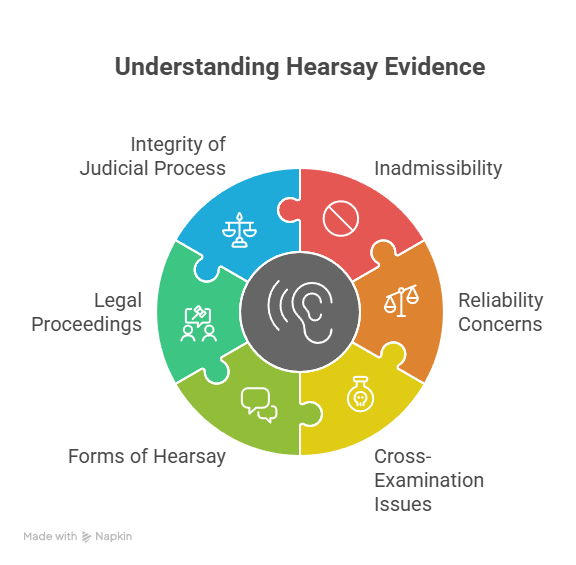Evidence is the foundation of justice. Courts rely on credible and admissible evidence to establish the truth, resolve disputes, and uphold the rule of law. Among different types of evidence, “hearsay” has always occupied a controversial position. While it may sometimes appear relevant, courts generally exclude it because it lacks reliability and prevents effective cross-examination.
In India, the law of evidence has undergone a historic transition. The Indian Evidence Act, 1872 (IEA)—a colonial-era legislation—governed admissibility of evidence for more than 150 years.
In 2023, Parliament enacted the Bharatiya Sakshya Adhiniyam, 2023 (BSA), replacing the IEA with the aim of modernizing evidentiary rules. This blog examines how both statutes deal with hearsay evidence, highlights key judicial interpretations, and evaluates whether India’s evolving approach strikes the right balance between fairness and justice.
Understanding Hearsay Evidence
Hearsay evidence refers to statements made outside the court that are presented in court to prove the truth of the matter asserted. For example, if witness A testifies that “B told me that C committed the theft,” such testimony is hearsay because it is based on what B said rather than what A directly perceived.
Why is hearsay inadmissible?

- Lack of direct knowledge – the person testifying does not have firsthand experience.
- No cross-examination – the original declarant cannot be tested for truthfulness.
- Risk of fabrication – statements may be altered, exaggerated, or misunderstood.
Common law countries, including India, generally reject hearsay except under specific exceptions where necessity and reliability justify admission.
Exceptions to the Rule against Hearsay under IEA
Despite strict exclusion, the IEA recognized that in certain situations, hearsay is both necessary and reliable. Some key exceptions:
- Dying Declarations (Section 32(1)) – Premised on the maxim “Nemo moriturus praesumitur mentiri” (a man will not meet his maker with a lie in his mouth). Example: Khushal Rao v. State of Bombay (1958) upheld reliability of dying declarations.
- Res Gestae (Section 6) – Statements made contemporaneously with the act form part of the same transaction. Example: Rattan Singh v. State of H.P. (1997) recognized spontaneous utterances as admissible.
- Admissions & Confessions (Sections 17–30) – Statements against one’s own interest are considered inherently reliable.
- Statements by Persons Who Cannot be Called as Witnesses (Section 32) – Includes situations like death, absence, incapacity, or being beyond jurisdiction.
- Expert Opinions (Sections 45–51) – Expert testimony is admissible when the subject is beyond ordinary understanding.
- Electronic Records (Section 65B) – Introduced later to deal with digital evidence. The landmark case Anvar P.V. v. P.K. Basheer (2014) strictly enforced Section 65B for electronic evidence admissibility.
These exceptions show that the IEA adopted a pragmatic approach—hearsay is inadmissible by default but allowed when justified by necessity and circumstantial reliability.
Hearsay Evidence under the Bharatiya Sakshya Adhiniyam, 2023
The BSA, enacted as part of India’s new criminal law framework, repeals the IEA but retains the same core principles.
- Sections 56 and 57 (BSA) correspond to Sections 59 and 60 (IEA), mandating that oral evidence must be direct.
- Exceptions preserved – Dying declarations, res gestae, admissions, confessions, statements of unavailable persons, expert opinions, and electronic records remain valid.
- Digital Evidence – The BSA gives stronger recognition to electronic records, reflecting the centrality of digital communication in contemporary disputes. For instance, provisions related to electronic records have been reorganized and simplified for clarity.
Conclusion
Hearsay evidence in India has travelled from the Indian Evidence Act, 1872 to the Bharatiya Sakshya Adhiniyam, 2023 with remarkable continuity. Both statutes affirm the principle that hearsay is inadmissible, except under carefully circumscribed exceptions rooted in necessity and reliability.
While the BSA modernizes drafting and foregrounds electronic evidence, it does not depart from the long-established jurisprudence under the IEA. Thus, judicial precedents under the IEA will continue to guide courts in applying the BSA.
The enduring challenge for Indian law is to strike the right balance: procedural fairness through exclusion of unreliable hearsay, and substantive justice through pragmatic exceptions. As India navigates a digital future, the adaptability of hearsay doctrine—especially concerning electronic records—will define the fairness and effectiveness of its evidence law.




